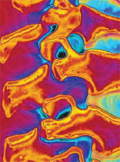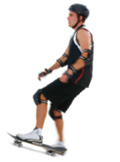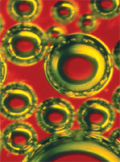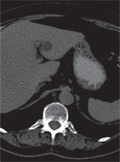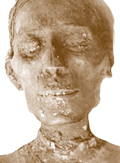The eLitMed.hu medical portal uses computer cookies for convenient operation. Detailed information can be found in the Cookie-policy.
Lege Artis Medicinae - 2012;22(03)
Content
[Bacterial contamination and irritable bowel syndrome]
[Irritable bowel syndrome (IBS) is one of the most common gastrointestinal condition, which affects 10-15% of adults in developed countries. Recent observations have raised the possibility that disturbances in the gut microbiota and/or the accompanying low-grade inflammatory state might contribute to the etiology and symptomatology of irritable bowel syndrome. Some studies indicate that small intestinal bacterial overgrowth (SIBO), as confirmed by hydrogen breath tests (HBT), is more prevalent in patients with irritable bowel syndrome than in matched controls without IBS. Although the data are conflicting, this observation has led to the hypothesis that bacterial contamination was the primary cause of IBS. As a consequence of this hypothesis, a lot of therapeutic options have found their way into the armamentarium of those who treat patients with IBS. These agents include probiotics, prebiotics, antibiotics and anti-inflammatory agents. This paper describes the various mechanisms by which changes in the gut flora might contribute to IBS and also discusses the efficacy and safety of antibiotic therapies, especially rifaximin, for treating IBS/SIBO symptoms.]
[Epidemiological surveillance systems used by international organisations in military crisis management operations]
[Facing new challenges and growing requirements, the renewal and adjustment of doctrines, methods and technology is an indispensable progressive need for modern militaries. In order to achieve the maximal protection of troops and conservation of fighting strength, innovation is continuous and has greatly accelerated in the whole spectrum of Force Health Protection. Owing to the development of technology, portable capabilities that had been available only in the hinterland have become available in the military medical support area. Utilising mobile information technology solutions, the continuous, real-time information flow between the tactical level medical units and the higher level medical analysts and decision makers has become technically feasible, which results in a significant widening of epidemiological surveillance capabilities as well. We discuss the current challenges of expeditionary- type military operations and their general epidemiological aspects and the morbidity reporting and monitoring systems used in international military missions. Furthermore, we overview the milestones of the development of the NATO near-real-time epidemiological surveillance system, the NATO Deployment Health Surveillance Capability, which functions as a branch of the Budapestbased multinational NATO Centre of Excellence for Military Medicine.]
[Clinical aspects of ischaemic bowel disease]
[Decreased blood flow through the intestines leads to mesenteric ischaemia, which is characterised by cellular damage due to the lack of oxygen and nutrients. Extensive collateralisation between splanchnic vessels serves as a protective mechanism against ischaemia. Intestinal ischaemia can be classified on the basis of its timing, location and the vessels involved. Acute mesenteric ischaemia can result from arterial embolisation, arterial or venous thrombosis, or vasoconstriction secondary to systemic circulation disorder associated with hypovolaemia. Chronic mesenteric ischaemia develops as a consequence of partial or complete occlusion of splanchnic vessels. Colonic ischaemia is mainly caused by a limited circulation disorder of the inferior mesenteric artery. Mortality rates for the various forms of acute mesenteric ischaemia are different. However, early diagnosis before bowel infarction might improve survival. This paper summarises the cilical aspects, diagnosis and therapeutic options of intestinal ischaemia.]
[The new British recommendations for the treatment of lower back pain on the basis of the new NICE guidelines - comparison with the Hungarian therapeutic practice]
[The new NICE guidelines on lower back pain emphasise the importance of clinical assessment. Radiological imaging methods are used primarily to exclude severe diseases, such as tumour, infection, trauma or inflammation. It’s crucial to inform patients and encourage them to use self-management and stay active. Pain management is guided by the analgesic ladder. A complex physical and psychological treatment is used, which involves a structured exercise programme, manual therapy and acupuncture, taking into account the preferences of the patient. Depending on the aetiology, surgical intervention should be considered in therapy-resistant cases. Finally, the authors compare the above guidelines with the Hungarian practice in this field.]
[Possibilities of applying basis/bolus method in treatment of adolescent with type 1 diabetes mellitus]
[INTRODUCTION - Since the end of the pastcentury, the basis/bolus method has been adeterminate factor of adjusting insulin thera-py. Experiences with insulin pump treatmentprove that well-quantified and adequatelytimed basal insulin treatment can fully com-pensate for the diurnal glucose-producingactivities of the liver and the diurnal changesin the activity of insulin receptors. Suitablyselected basal insulin treatment can, there-fore, keep the changes in blood sugar levelthat are dependent of the diet’s carbohydratecontent well under control. CASE REPORT - By presenting the approxi-mately five-year treatment of an adolescentboy, the author presents the current options(and failures) of insulin therapy that might beused with more or less success. Each treat-ment approach had its place in the variousstages of the patient’s diabetes. Nevertheless,insulin pump therapy, admittedly the moststate-of-the-art method today was unsuccess-ful due to patient’s lack of compliance, thusthis treatment had to be stopped. Still, on thebasis of the experiences with insulin pumptherapy, the restored intensive-conservativetreatment was set up on glargine basalinsulin, defining doses of bolus in correlationwith 10 grams of carbohydrate, which madethe diet less strict. This approach resulted ina considerable improvement of the patient’smetabolic profile. CONCLUSION - The right choice of thedoses and efficacy curve of basal insulin isessential for achieving a good metabolic bal-ance during intensive-conservative therapy.In case of deteriorating metabolic balance,suspending the inefficient insulin pump ther-apy is justified and means no disadvantagefor the patient, as long as the subsequentadjustment is prudent. By defining doses of ashort-acting bolus insulin analogue in corre-lation with carbohydrate intake along withglargine therapy permits adaptation to themetabolism of patients with poor compli-ance and unsatisfactory lifestyle - in expec-tation of better results. ]
[What is the doctor like, if female? - Female doctors’ ideal image based on empirical studies]
[The aim of our study was to examine thestereotypes about female doctors and howdo the female medical students perceivethe working female doctors whom are theirrole models. In the first study (247 from theAlbert Szent-Györgyi Medical and Pharma-ceutical Centre at the University of Szegedand 256 from the Medical and HealthScience Centre of the University ofDebrecen) the female medical students’professional socialization was compared tothe male counterparts’. In the second study(from University of Szeged, 214 femalemedical students, 132 female jurist stu-dents) female medical and jurist students'professional socialization was comparedincluding the comparison of stereotypes inconnection with working female doctorsand jurists. Female medical students’ professionalsocialization is different that of male coun-terparts in several aspects: being morealtruistic, more family centered, gettingcommited to the profession earlier, havingmore ambiguous carrier planes, and asmaller percentage of their parents’ has adegree or is a medical doctor, then for malemedical students. The female medical doc-tor has positive, idealistic, altruistic charac-ters according to both female studentgroups’ opinions. The female doctor’simage is more often associated with char-actersitics implying problems by femalemedical students then jurists. The unfold-ing image of these stereotypes is a femaledoctor who is willing to help, however,faceing lots of hardnesses during work.If the female medical students’ image of theproblematic life of these idealistic femaledoctors’ is known, it provides an opportu-nity to prepare them for the hardnessesthey’ll face avoiding role conflicts andhealth problems in the future.]
1.
Clinical Neuroscience
[Headache registry in Szeged: Experiences regarding to migraine patients]2.
Clinical Neuroscience
[The new target population of stroke awareness campaign: Kindergarten students ]3.
Clinical Neuroscience
Is there any difference in mortality rates of atrial fibrillation detected before or after ischemic stroke?4.
Clinical Neuroscience
Factors influencing the level of stigma in Parkinson’s disease in western Turkey5.
Clinical Neuroscience
[The effects of demographic and clinical factors on the severity of poststroke aphasia]1.
2.
Clinical Oncology
[Pancreatic cancer: ESMO Clinical Practice Guideline for diagnosis, treatment and follow-up]3.
Clinical Oncology
[Pharmacovigilance landscape – Lessons from the past and opportunities for future]4.
5.







